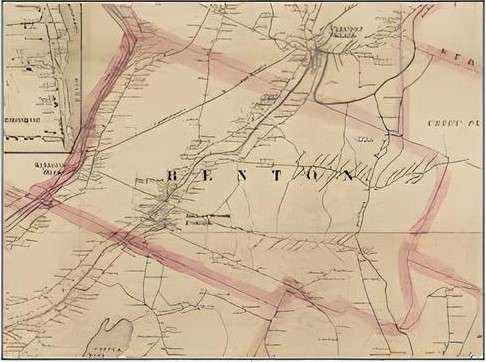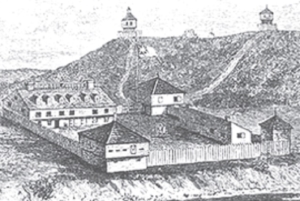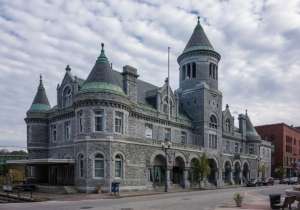Up and down the Kennebec Valley: Fairfield
by Mary Grow
This article brings readers to Fairfield, northernmost of the four municipalities in this series on the west bank of the Kennebec River. Fairfield is across the river from Benton and Clinton (subjects of the June 13 and June 20 articles).
Fairfield is one of the two towns in the series outside Kennebec County; it is far enough north to be in Somerset County. (Palermo, in Waldo County, is the other outsider; see the July 4 history article.)
Fairfield was settled and incorporated only on the west side of the river, unlike Augusta, which began and still is on both banks, or Vassalboro and Winslow, which lost their west sides (the names of Waterville, originally Winslow, and Sidney, originally Vassalboro, remain to be discussed).
The present town started as Fairfield Plantation, according to a history on the town’s website. The 1988 bicentennial history book, prepared by the book committee of the Fairfield Historical Society, says the plantation was organized in 1774, and the town was incorporated June 18, 1788.
Why Fairfield? When your writer summarized the town’s history in an April 16, 2020, article in this series, she quoted Ava Harriet Chadbourne’s Maine Place Names as saying the name was due to the area’s “natural beauty.”
An unrelated on-line account supports Chadbourne. It says Fairfield, California, was named by an early settler after his home town of Fairfield, Connecticut, and cites a 1903 issue of the monthly Connecticut Magazine saying Fairfield, Connecticut’s “name is descriptive of the tract.”
When Fairfield? is a question one writer in the bicentennial history raises. Most of its authors referred to the 1788 town as Fairfield, and called only the present downtown section Kendall’s Mills, named for an entrepreneur who arrived in 1780.
The writer of the chapter titled Military Involvement, however, wrote, “Because of William Kendall’s dominance in the Town it was known as Kendall’s Mills until the name was changed to Fairfield in 1872.” Another chapter says the name of the Kendall’s Mills post office, not the town, became Fairfield in 1872.
The town was not named after its first settler: multiple sources say he was Jonathan Emery, who in 1771 “built a house on Emery Hill [a short distance north of today’s downtown] near the banks of the Kennebec River.”
The bicentennial history says the house started as a log cabin that was “later sheathed with boards” and otherwise modified. Cianbro Corporation took it down in 1982, the history says.
Jonathan Emery came from Dracut, Massachusetts. His son Samuel, born June 15, 1773, was probably the first white child born in Fairfield, the history says (but see below).
On-line Emery genealogies are full of arguments and contradictions. Majority opinion says Jonathan (born Nov. 23, 1722, in Haverhill, Massachusetts; died June, 1807, in Fairfield) was married twice. His first wife was Jerusha or possibly Johannah (Barron) Emery, from Dracut, Massachusetts, born Aug. 4, 1735. She and Jonathan had nine or 10 children before she died in 1781.
One genealogy identifies Jonathan’s second wife as NN. Another calls her a widow named Whitten. Neither provides dates.
Several sources say Emery came first to Winthrop and then to Fairfield. None explains why he came to Maine.
Contemporary downtown Fairfield began with the first dam built to use a portion of the Kennebec’s water power. It ran from the west bank to the island now called Mill Island, the westernmost and largest of half a dozen islands in that stretch of river. Jonas Dutton started building the dam in 1778; in 1780, Revolutionary veteran William Kendall came to Fairfield and took it over.
Kendall (Sept. 11, 1759 – Aug. 11, 1827) was born in Georgetown. The bicentennial history says he joined the army as a private in March 1777, and was honorably discharged in 1780. Why he came to Fairfield is unstated.
He bought and finished Dutton’s dam and built a sawmill and a grist mill on top of it. The mills remained in the family until 1835.
Several sources tell the story of Kendall paddling his birchbark canoe upriver on Christmas Day 1782, to marry Abigail Chase and bring her back to his Fairfield home. The bicentennial history is inconsistent about where Abigail lived and which house her new husband brought her to.
The chronological introductory section says he “brought her down the Kennebec from what is now Hinckley.” Most sources call Hinckley the site of the former Pishon’s Ferry (where the Kennebec has been bridged since 1910).
The writer of the Military Involvement chapter specified Noble’s Ferry, which was downriver from Pishon’s Ferry. (See the June 20 article on Clinton.)
The history says Kendall’s first house was a log cabin near the river, at the north end of the present downtown area. The writer of the introduction said the couple lived there until the late 1790s, when they moved into a large brick house farther south and farther from the river.
The Military Involvement writer implied that immediately after putting up the log cabin, Kendall “proceeded to dig a cellar and to build the first frame house in the village.” He brought his bride down the river “to the home he had recently completed.”
Kendall also bought land downstream from his dam, starting the present commercial center. The history says he ran a store farther south on the river until he died in 1827.
Kendall’s Mills, and now downtown Fairfield, was/is in the southeastern corner of town. The local histories list another half-dozen early population centers, three upriver from Kendall’s Mills and three in the rest of town.
The next upriver settlement has been called Shawmut since 1889; previous names included Philbrooks Mills, Lyons Mills and Somerset Mills (the name of the post office there from 1853 to 1889). The area was farmland until 1835, the history says, when Ivory Low “bonded his farm with the water power to Milton Philbrook of Fairfield for the round sum of $40,000.”
Philbrook presumably built a dam, though that fact is not recorded. His original mill soon changed hands; Waterville lawyer Alpheus Lyon built Fairfield’s first flour mill there. The history does not explain the names Somerset Mills and Shawmut.
Next up the river was Nye’s Corner, where the post office was Fairfield Corners from 1822 to 1882, the history says. Named for the numerous Nye family, this village in the 1830s was “the hub of the Town with its stores, church, hotel, blacksmith shop, hat manufacturer, cooper shops, coat and shoe shops and carriage shops.”
About eight miles upstream from Kendall’s Mills, at Pishon’s Ferry, was East Fairfield, now Hinckley, in the northeastern corner of town. The name Hinckley, the bicentennial history says, honors George Walter Hinckley, founder in 1889 of the Goodwill Home and School.
Of the three inland settlements, the southernmost, almost due west of Kendall’s Mills, is Fairfield Center. Northward, inland from Nye’s Corner, is North Fairfield; and in the northwest corner of town is Larone.
Neither the on-line nor the printed town history is clear on the origin of the Fairfield Center settlement. It might be part of acreage on the west bank of the Kennebec purchased by two Massachusetts men, Joseph Dimmock and Joseph Nye, on Oct. 11, 1781.
Dimmock and Nye were required to survey 60 195-acre lots and find settlers for them and to build three roads in the tract. If your writer has correctly located their land, they succeeded: the bicentennial history says Fairfield Center, on the main road from Waterville to Skowhegan, had the Fairfield post office from 1807 to 1872, and stores and taverns that made it the town’s “business section” (no dates given).
North Fairfield’s first settlers the bicentennial history describes as “a group of Quakers from Massachusetts” – hence one of its early names, Quakertown. It was also known as Black’s Mills and Blacknell’s Mills, for reasons your writer has not ascertained. The Bowerman brothers, Elihu, Harper and Zaccheus, were the initial settlers.
(There is more about the Bowermans in the history article in the April 20, 2016, issue of The Town Line.)
The village of Larone is in extreme northwestern Fairfield, on Martin Stream. Martin Stream, which the bicentennial history says is named for an early trapper (no first name given), flows into the Kennebec River at Hinckley.
The history says the first settler was Abraham Potter, who paid Massachusetts $1.25 an acre for his farmland. Opening a road to Norridgewock encouraged more settlers, including Daniel Winslow (no date given) who dammed the stream and built “a mill for tanning purposes, a grist mill and later a lath saw.”
The village was therefore called Winslow’s Mills until residents wanted their own post office and a new name for it. Citing an earlier history specifically of Larone, the bicentennial history says during a meeting organized to discuss the post office, Tilly Emery, who owned a roan horse, offered “the roan,” “meaning that if no other way was provided, his horse could bring…[the mail] in.”
Others present amended “the roan” to “Larone,” “and the named was unanimously adopted.”
The writer added that “Mr. Emery became the first postmaster, although Mrs. Emery did most of the business.”
A contemporary on-line map shows these seven early Fairfield settlement centers (plus three other localities).
Two more second-generation Emerys
Some of the varying lists of Jonathan and Jerusha Emery’s children begin with Private David, born in Dracut in 1754. One list, of six sons and four daughters, includes Samuel; two sources say he was born June 17, 1773, in Winthrop (not Fairfield).
An 1890 genealogy, copied on a newer genealogical site, says when Benedict Arnold’s expedition to Québec went through Fairfield in September 1775, 21-year-old David Emery joined and went as far as Dead River. When Lieutenant Colonel Roger Enos and about 450 men turned back from there late in October, Emery came with them.
(Dead River is about 80 miles north and west of Fairfield. Roger Enos [1729 -1808] was a Connecticut native who had been a soldier since 1759 [the French and Indian War]. He was court-martialed for leaving Arnold’s expedition; defended himself on grounds of the lack of food, supplies and boats for the troops; was acquitted and rejoined the army.)
Emery then served in the army outside Boston until March 1777. He spent two years at Ticonderoga, New York, the genealogist wrote, before going to Valley Forge, Pennsylvania, to join General George Washington’s Life Guards.
Discharged in March 1780, at Morristown, New Jersey, he returned to Fairfield. The genealogist found an April 5, 1782, record of marriage intentions between “David Emery and Abigail Goodwin [1763 – 1838] both of Kennebeck River without the boundaries of any town, but in the county of Lincoln.” The marriage did not get recorded because the town was not incorporated, the genealogist explained.
David and Abigail had six sons and four daughters. David died in Fairfield on Nov. 18, 1830, and is buried in Emery Hill Cemetery.
Another genealogy says David’s younger brother, Samuel (the one who might have been Fairfield’s first white child), married Deidamia Johnston, whose date and place of birth are unknown. Between April 1786 and April 1817, the couple had 11 children whose names are listed – the website says there were a total of 15.
The children were born in Fairfield except for William (Nov. 20, 1801) and Samuel (May 22, 1810), who were born in Phippsburg, this source says (without explanation).
Samuel was 69 when he died March 7, 1839, in Fairfield; he, too, is buried in Emery Hill Cemetery. Neither Deidamia nor her sister-in-law Abigail have identified graves there.
Main sources
Fairfield Historical Society, Fairfield, Maine 1788-1988 (1988)
Websites, miscellaneous






















